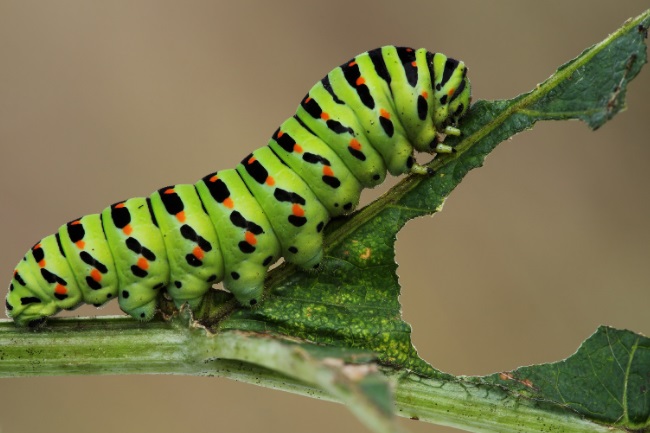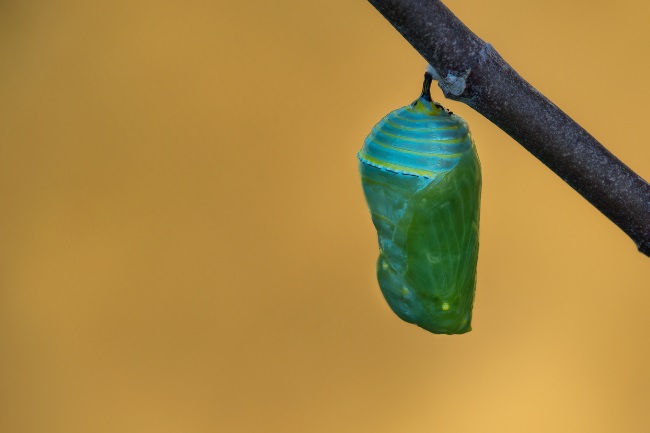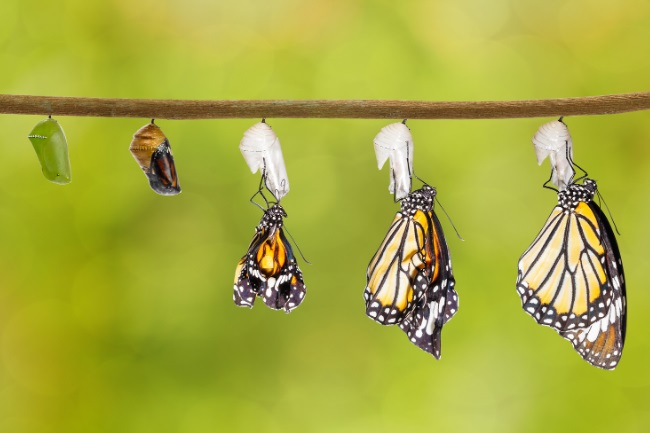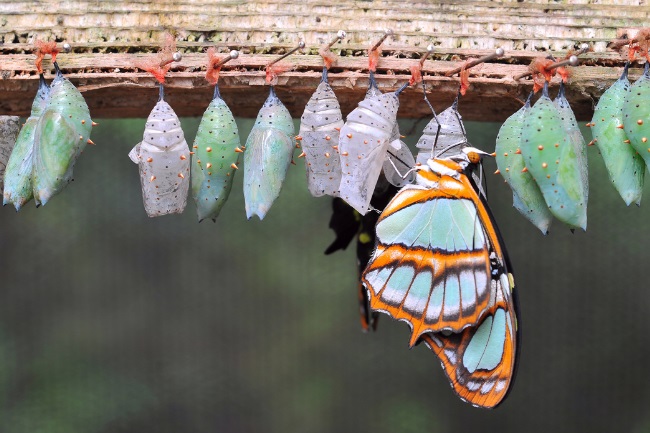A caterpillar becomes a chrysalis by struggling out of its exoskeleton and emerging in its new body form. While we think of the chrysalis as containing the caterpillar, the chrysalis is the caterpillar.
Contents
What is a caterpillar?

Caterpillars are the larvae young or butterflies and moths. Their first life stage is within an egg, laid by the adult. Having emerged, they eat constantly in order to build up the energy to grow.
Each growth spurt requires the caterpillar to shed its skin, wriggling free of its old exoskeleton, in order to expand. This is because the exoskeleton, and external skeleton that provides protection and structure to the insect, cannot grow with the insect.
Having grown to its ultimate size, the next stage is to transform into something entirely new, a chrysalis.
Also read: Is a Caterpillar an Insect? (Explained)
Pupa, chrysalis or cocoon?

The words pupa, chrysalis or cocoon are often used interchangeably. Both pupa and chrysalis refer to the stage in a caterpillar’s lifecycle where it metamorphosises in order to become an adult.
While we may have come to think of the pupa or chrysalis as something that surrounds the caterpillar, this alien-looking thing is actually the caterpillar itself. The caterpillars transform into this form by once again shrugging off its exoskeleton and emerging completely changed.
A cocoon by comparison is a structure that the caterpillar weaves around itself, made of a kind of silky thread. Cocoons can be highly complex or simply a few scattered strands. They can help to keep the pupa or chrysalis safe and hidden or hold it into place.
Chrysalis and pupa can look wildly different depending on the species of butterfly or moth. Some are very plain, a brown or white oval structure, while others can be beautifully sculptural, with textured surfaces and delicate patterns.
| Stage | Description |
|---|---|
| Preparing for Pupa | Caterpillar attaches itself to a suitable surface and forms a silk pad |
| Shedding Skin | Caterpillar sheds its outer layer, revealing the chrysalis underneath |
| Chrysalis Formation | Caterpillar secretes a protective casing around its body, known as a chrysalis |
| Transformation | Inside the chrysalis, the caterpillar undergoes metamorphosis into a butterfly |
| Emergence | The fully developed butterfly emerges from the chrysalis |
Different species also locate themselves in different places. The common blue will simply develop into a pupa on the ground under its food plant. Monarch butterflies will attach themselves to an object like a plant stem or leave, using silken thread to hold themselves in place.
Caterpillars use silk in different ways, some tie it around their waist to keep themselves attached to a plant, others use it to create a hammock under a leaf. Many species simply use the silk to attach themselves to a stem while the hang inside down.
Also read: What Caterpillars turn into Monarch Butterflies? (A List)
How long does it take?

How long it takes a caterpillar to go through its metamorphosis depends hugely on the species and time of year.
Many species have more than one lifecycle a year, this means that the earlier generations will usually develop quickly because the food and conditions are good, whereas later generations may have to remain in their pupa over winter, in temperate climates because conditions are not suitable for them to emerge.
Around 10 to 14 days is typically the minimum for a transformation, but overwintering young may have to wait months to emerge.
When do caterpillars metamorphosis?
In temperate regions, many species will emerge in the late spring and early summer. This is usually the optimum time for them to have young, as there is plenty of food available.
Many species will aim to emerge at a similar time to when their main food species is available.
What affects its ability to make a chrysalis?
Throughout its life, a caterpillar is trying to eat enough to build up energy reserves to grow and transform into an adult.
A great deal depends on being able to find enough to eat. If a caterpillar can’t fatten up enough, it may never get to the stage of making a chrysalis and may simply die a caterpillar.
Other things that can influence a caterpillar’s ability to pupate successfully can be things like chemical contamination. This could come from feeding on plants that have been sprayed with chemicals, either to help them grow or to kill off pests and diseases.
Parasites and fungal infections can also affect pupa. Weather conditions are also important. Pupa can overheat or be more likely to suffer from moulds in damp still air.
| Type | Description |
|---|---|
| Exposed Chrysalis | Chrysalis formed on the outer surface of plants |
| Concealed Chrysalis | Chrysalis formed inside a shelter or leaf |
| Suspended Chrysalis | Chrysalis suspended from a silk thread or branch |
| Underground Chrysalis | Chrysalis formed underground for protection |
In the end, this stage in a caterpillar’s life is a risky one, as it cannot move out of danger if required. Even simple bad luck can strike, such as its plant being cut or trampled by a larger animal.
Also read: What do Caterpillars Eat? (Vegan vs. Carnivore Caterpillars)
What happens inside?

The outer exoskeleton usually hardens to protect the caterpillar, but inside it has been turned into a living soup.
The caterpillar’s body breaks down to cell level so that it can rearrange itself into an entirely new form. Some parts of the body do remain fairly similar, such as the true legs, however, most of it’s body will be thrown out for a whole new model.
Also read: How Does a Caterpillar Turn Into a Butterfly? (Explained)
A whole new world
The image of a butterfly or moth emerging from its chrysalis is certainly an ionic one. For many people, it represents a symbol of rebirth, new hope and transformation.
For the new winged version of the insect, life is now all about love, finding that special someone, and producing the next generation of young who will start the whole journey all over again.

